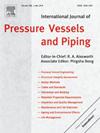Synchronously improving strength and toughness for pipeline steel weld via cerium adding
IF 3
2区 工程技术
Q2 ENGINEERING, MECHANICAL
International Journal of Pressure Vessels and Piping
Pub Date : 2025-02-14
DOI:10.1016/j.ijpvp.2025.105466
引用次数: 0
Abstract
The requirement for higher pressure gas flows and lower temperature service environments has emphasized the necessity to solve the trade-off between strength and impact toughness in pipeline steel weld. In this study, the strength and toughness were improved synchronously via cerium adding, and the strengthening-toughening mechanism and fracture behavior of the weld were revealed by multi-scale characterization. The research results indicated that the addition of Ce in 50–100 ppm can change the inclusion the inclusion from a single Al2O3 to a mixture of Al2O3 and CeAlO3, and refines the its size. In addition, the original austenite grain size, acicular ferrite size and grain boundary ferrite fraction also decrease. The reduction of grain boundary ferrite and inclusions effectively inhibited the crack initiation position, which increased the yield strength from 584±11 MPa to 629±11 MPa and 603±12 MPa, the impact toughness from 73±11 J to 123±12 J and 107±12 J. Therefore, with the Ce content from 0 to 50 ppm and 100 ppm, the strength and toughness of the weld appear to increase and then decrease. Moreover, the coarse grain boundary ferrite cannot produce coordinated deformation due to its low Schmidt factor, resulting in the fracture of grain boundary ferrite, which seriously decrease the crack propagation energy.
通过添加铈同步提高管道钢焊缝的强度和韧性
对高压气流和低温使用环境的要求强调了解决管道钢焊缝强度和冲击韧性之间权衡的必要性。在本研究中,铈的加入同步提高了强度和韧性,并通过多尺度表征揭示了焊缝的增韧机理和断裂行为。研究结果表明,在50 ~ 100 ppm范围内添加Ce可使夹杂物由单一Al2O3变为Al2O3和CeAlO3的混合物,并使夹杂物的粒径细化。原始奥氏体晶粒尺寸减小,针状铁素体晶粒尺寸减小,晶界铁素体分数减小。晶界铁素体和夹杂物的减少有效地抑制了裂纹的起裂位置,使屈服强度从584±11 MPa提高到629±11 MPa和603±12 MPa,冲击韧性从73±11 J提高到123±12 J和107±12 J。因此,当Ce含量从0到50 ppm和100 ppm时,焊缝的强度和韧性呈现先增大后减小的趋势。粗晶界铁素体由于施密特系数低,无法产生协调变形,导致晶界铁素体断裂,严重降低了裂纹扩展能。
本文章由计算机程序翻译,如有差异,请以英文原文为准。
求助全文
约1分钟内获得全文
求助全文
来源期刊
CiteScore
5.30
自引率
13.30%
发文量
208
审稿时长
17 months
期刊介绍:
Pressure vessel engineering technology is of importance in many branches of industry. This journal publishes the latest research results and related information on all its associated aspects, with particular emphasis on the structural integrity assessment, maintenance and life extension of pressurised process engineering plants.
The anticipated coverage of the International Journal of Pressure Vessels and Piping ranges from simple mass-produced pressure vessels to large custom-built vessels and tanks. Pressure vessels technology is a developing field, and contributions on the following topics will therefore be welcome:
• Pressure vessel engineering
• Structural integrity assessment
• Design methods
• Codes and standards
• Fabrication and welding
• Materials properties requirements
• Inspection and quality management
• Maintenance and life extension
• Ageing and environmental effects
• Life management
Of particular importance are papers covering aspects of significant practical application which could lead to major improvements in economy, reliability and useful life. While most accepted papers represent the results of original applied research, critical reviews of topical interest by world-leading experts will also appear from time to time.
International Journal of Pressure Vessels and Piping is indispensable reading for engineering professionals involved in the energy, petrochemicals, process plant, transport, aerospace and related industries; for manufacturers of pressure vessels and ancillary equipment; and for academics pursuing research in these areas.

 求助内容:
求助内容: 应助结果提醒方式:
应助结果提醒方式:


